Policies
A policy represents a collection of filters. It is assigned to an organizational unit and controls filtering for all users in that particular unit. There are two types of policies:
Regular - Filters added to the regular policy are always active and have no time constraints as they are set up based on geolocation or IP address. See Creating a Regular Policy.
Time-based - Use a time-based policy to specify different filters for different time periods. For example, you can activate set one set of filters for morning hours, and activate a different set of filters for afternoon hours. See Creating a Time-based Policy.
Filters added to the regular policy are always active and have no time constraints.
Regular policies are used to filter content on Chromebooks and Windows OS devices.
To create a regular policy
Click Content Filtering from the Main Menu and then click Policies from its sub-menu. The Policies screen appears.
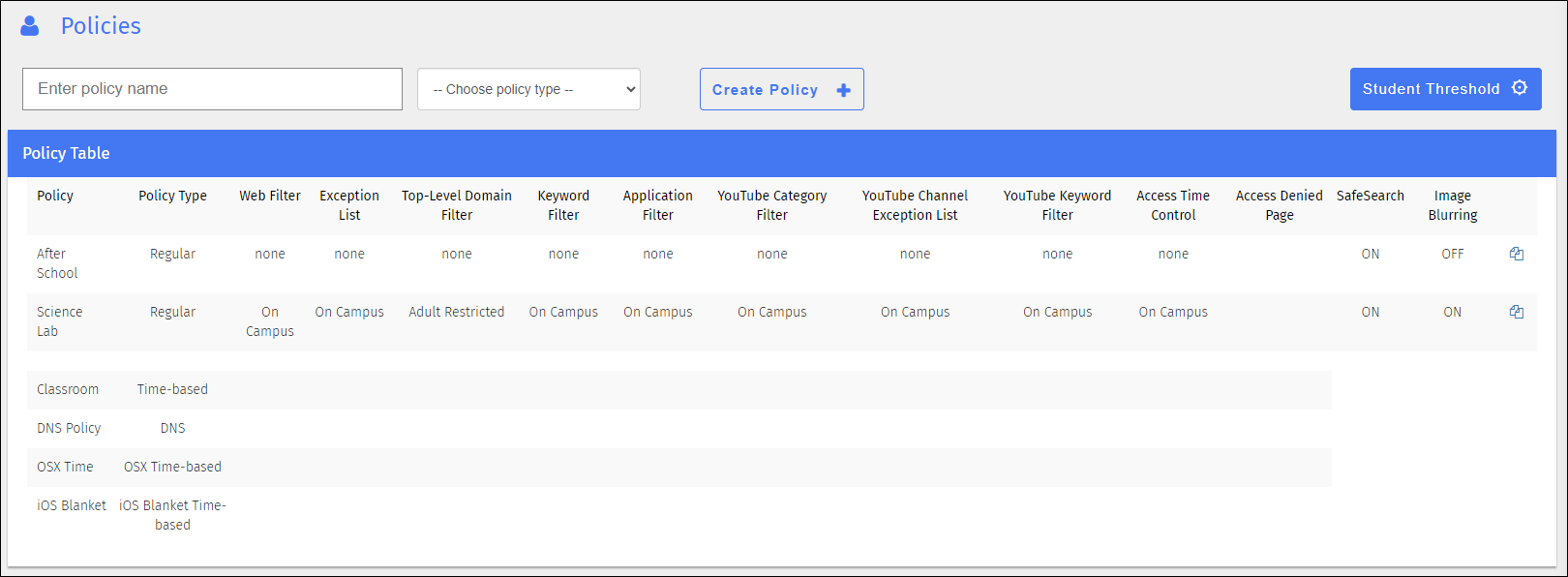
Type the name of the policy in the Enter policy name text field. Policy names must be longer than three characters.
Click Create Policy +. If you selected Regular, the following window opens.
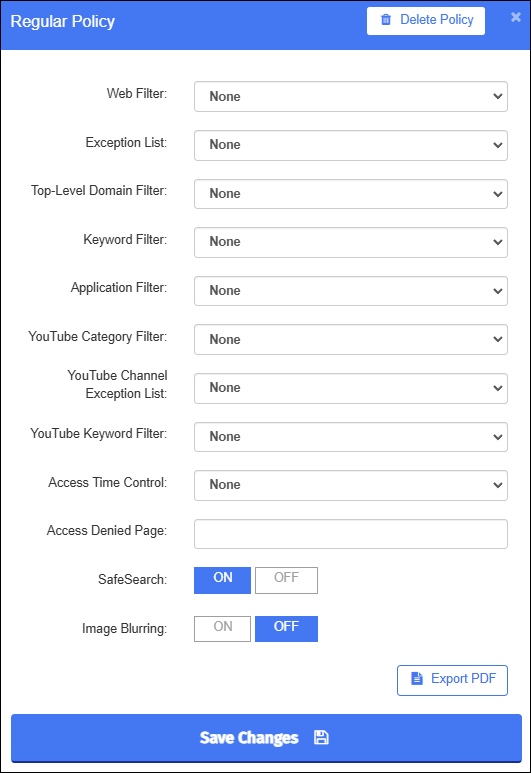
Select the appropriate filters to add to the selected policy from the drop-down lists. If you do not want to add a specific custom filter for a specific filter category, select None.
Type the URL in the Access Denied Page text box to direct students to a specific URL (e.g., your district’s web page) when access to a website is denied. If you activate Access Requests, then the default access denied page is used. If you do not have a specific URL redirect leave this text box empty and it will display the standard Blocksi Access Denied page when a blocked page is accessed.
Indicate whether to turn on SafeSearch for this policy and whether to blur adult images that you deem harmful to your students.
Click Save Changes. The new policy appears in the Policy Table.
OSX Regular policies are used to filter content on macOS devices.
To create an OSX regular policy
Click Content Filtering from the Main Menu and then click Policies from its sub-menu. The Policies screen appears.

Type the name of the policy in the Enter policy name text field. Policy names must be longer than three characters.
Select OSX Regular from the Choose policy type drop-down list.
Click Create Policy +. If you selected OSX Regular, the second window opens.
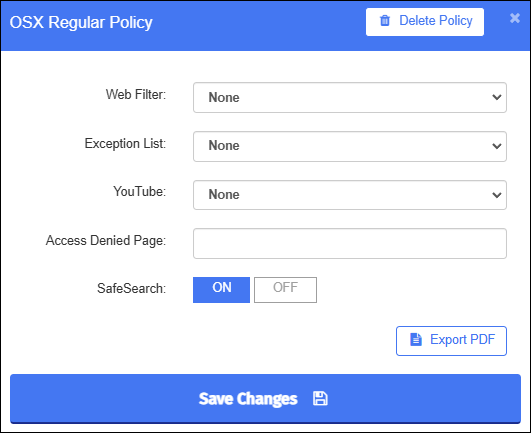
Select the appropriate filters to add to the selected policy from the drop-down lists. If you do not want to add a specific custom filter for a specific filter category, select None.
Type the URL in the Access Denied Page text box to direct students to a specific URL (e.g., your district’s web page) when access to a website is denied. If you activate Access Requests, then the default access denied page is used. If you do not have a specific URL redirect leave this text box empty and it will display the standard Blocksi Access Denied page when a blocked page is accessed.
Indicate whether to turn on SafeSearch for this policy and whether to blur adult images that you deem harmful to your students.
Click Save Changes. The new policy appears in the Policy Table.
Use time-based policies to specify different filters for different time periods. For example, you can activate set one set of filters for morning hours, and activate a different set of filters for afternoon hours.
Time-based policies are used to filter content on Chromebooks and Windows OS devices. For details on filtering content on MacBooks, see Creating an OSX Time-based Policy below. For details on filtering content on iPads, see Creating an iOS Blanket Time-based Policy below.
Creating the Policy
Click Content Filtering from the Main Menu and then click Policies from its sub-menu. The Policies screen appears.

Type the name of the policy in the Enter policy name text field.
Select Time-based from the Choose policy type drop-down list.
Click Create Policy +. The new policy appears in the Policy Table. and the following window opens. Note that time periods are in military time format.
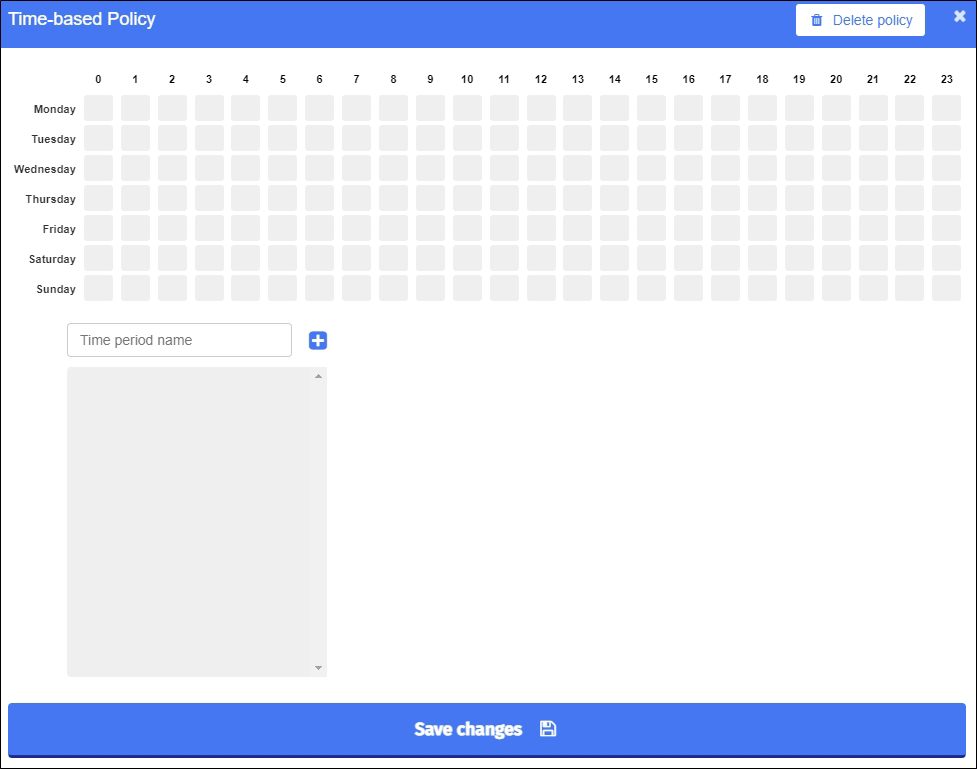
Adding the Time Periods
Type the name of the time period in the Time period name text box and click the blue plus sign. Time periods must have more than three characters. When you click the blue plus sign, the window expands to include the fields for the time-based policy, as shown below.
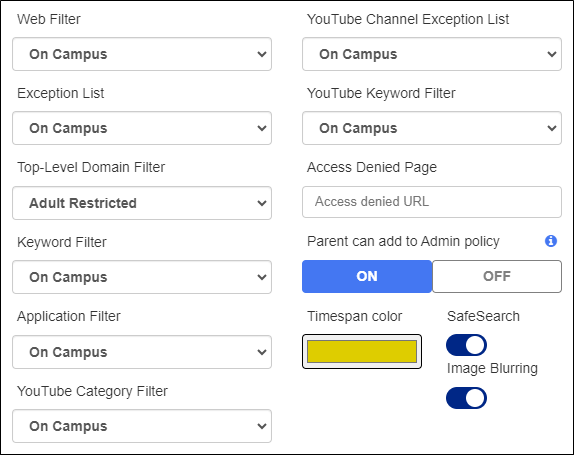
Select the appropriate filters to add to the selected policy from the drop-down lists. If you do not want to add a specific custom filter for a specific filter category, select None.
Type the URL in the Access Denied Page text box to direct students to a specific URL (e.g., your district’s web page) when access to a website is denied. If you activate Access Requests, then the default access denied page is used. If you do not have a specific URL redirect leave this text box empty and it will display the standard Blocksi Access Denied page when a blocked page is accessed.
Enable the Parent can add to Admin policy option to allow parents to add restrictions to this policy from their Parent Dashboard.
Note
This option is not available in the OSX Time-based and iOS Blanket Time-based policy windows.
Indicate the color for the time span on the chart.
Indicate whether to turn on SafeSearch and whether to turn on Image Blurring for this policy.
Click the box corresponding to the appropriate hour of the desired day to define the time period. For example, to select school hours of Monday - Friday 8 AM - 4 PM, click and hold the Monday-8 tile and drag to the Friday-16 tile. Repeat steps 1-2 to create additional time periods.
Click Save Changes.
Create as many time periods in a policy as you wish. For example, let’s say you wanted to create time periods for in school, after school, and weekends. Open the policy and repeat the steps in Adding the Time Periods for each additional time period you want to add to the policy. The following example shows a time-based policy that contains the three time periods mentioned previously. Note that each time period uses a different color scheme to indicate the hours and days to which it applies. Choose any colors you want to represent the time periods you create.
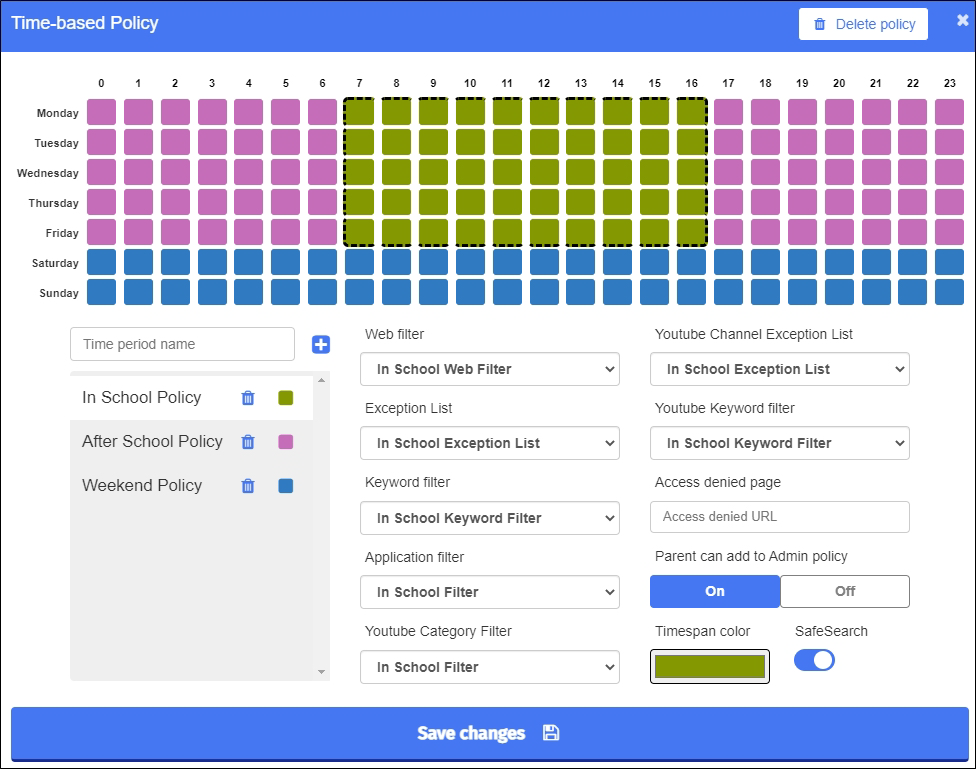
Use time-based policies to specify different filters for different time periods. For example, you can activate set one set of filters for morning hours, and activate a different set of filters for afternoon hours.
OSX Time-based policies are used to filter content on macOS devices. For details on filtering content on Chromebooks and Windows OS devices, see Creating a Time-based Policy above. For details on filtering content on iPads, see Creating an iOS Blanket Time-based Policy below.
Creating the Policy
Click Content Filtering from the Main Menu and then click Policies from its sub-menu. The Policies screen appears.

Type the name of the policy in the Enter policy name text field.
Select OSX Time-based from the Choose policy type drop-down list.
Click Create Policy +. The new policy appears in the Policy Table. and the following window opens. Note that time periods are in military time format.
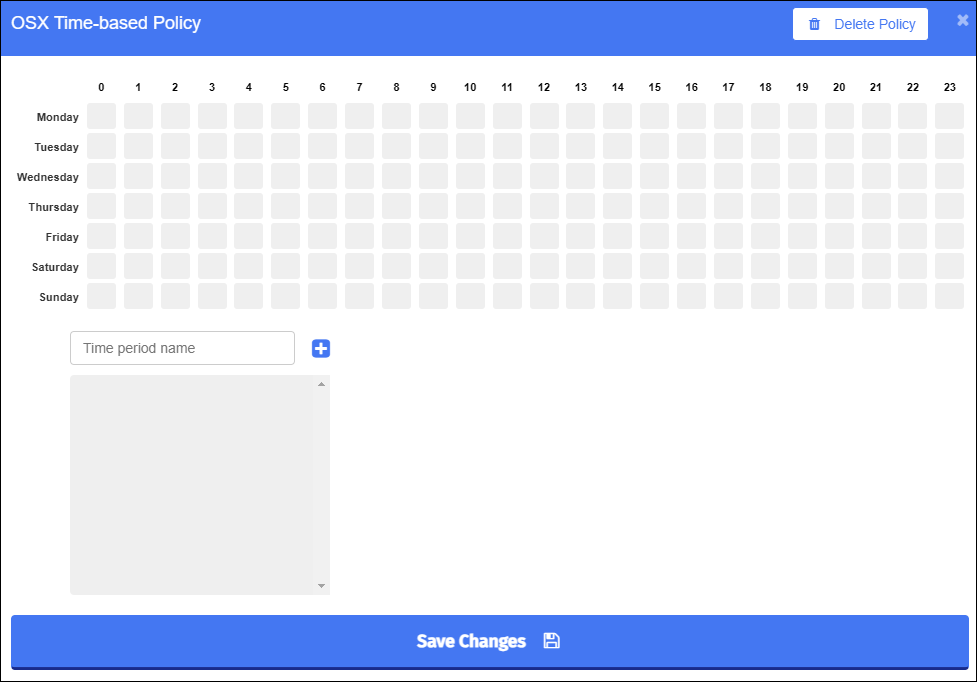
Adding the Time Periods
Type the name of the time period in the Time period name text box and click the blue plus sign. Time periods must have more than three characters. When you click the blue plus sign, the window expands to include the fields for the time-based policy, as shown below.
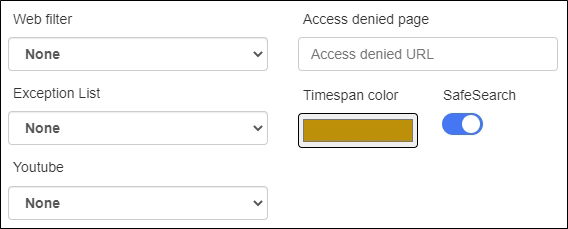
Select the appropriate filters to add to the selected policy from the drop-down lists. If you do not want to add a specific custom filter for a specific filter category, select None.
Type the URL in the Access Denied Page text box to direct students to a specific URL (e.g., your district’s web page) when access to a website is denied. If you activate Access Requests, then the default access denied page is used. If you do not have a specific URL redirect leave this text box empty and it will display the standard Blocksi Access Denied page when a blocked page is accessed.
Indicate the color for the time span on the chart.
Click the box corresponding to the appropriate hour of the desired day to define the time period. For example, to select school hours of Monday - Friday 8 AM - 4 PM, click and hold the Monday-8 tile and drag to the Friday-16 tile. Repeat steps 1-2 to create additional time periods.
Click Save Changes.
Create as many time periods in a policy as you wish. For example, let’s say you wanted to create time periods for in school, after school, and weekends. Open the policy and repeat the steps in Adding the Time Periods for each additional time period you want to add to the policy. The following example shows a time-based policy that contains the three time periods mentioned previously. Note that each time period uses a different color scheme to indicate the hours and days to which it applies. Choose any colors you want to represent the time periods you create.
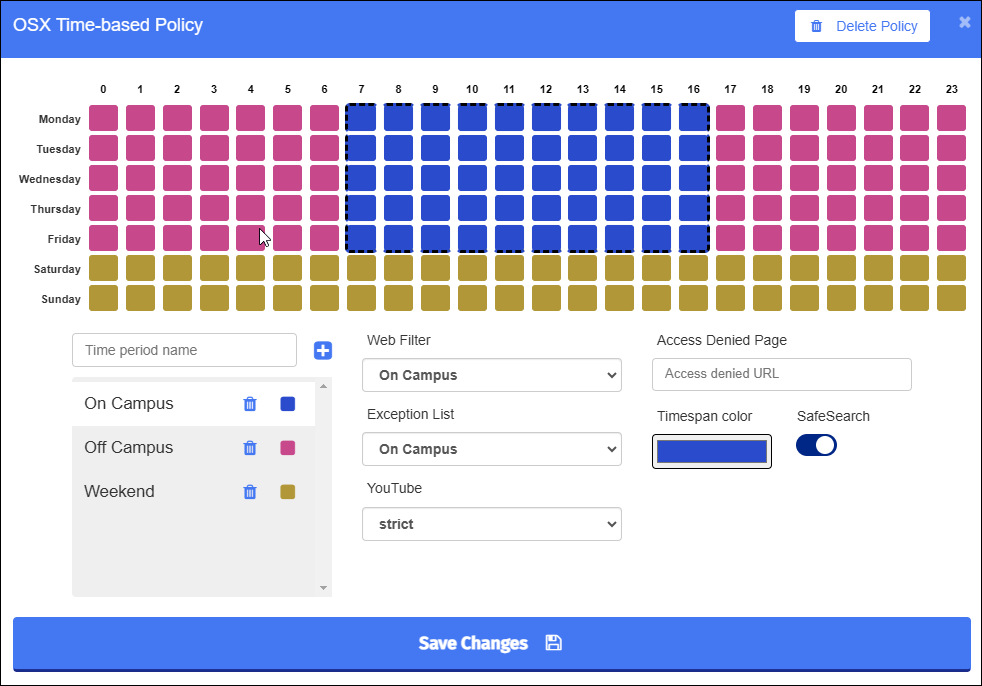
Use time-based policies to specify different filters for different time periods. For example, you can activate set one set of filters for morning hours, and activate a different set of filters for afternoon hours.
iOS Blanket Time-based policies are used to filter content on iPads. For details on filtering content on Chromebooks and Windows OS devices, see Creating a Time-based Policy above. For details on filtering content on macOS devices, see Creating an OSX Time-based Policy above.
Creating the Policy
Click Content Filtering from the Main Menu and then click Policies from its sub-menu. The Policies screen appears.

Type the name of the policy in the Enter policy name text field.
Select iOS Blanket Time-based from the Choose policy type drop-down list.
Click Create Policy +. The new policy appears in the Policy Table. and the following window opens. Note that time periods are in military time format.

Adding the Time Periods
Type the name of the time period in the Time period name text box and click the blue plus sign. Time periods must have more than three characters. When you click the blue plus sign, the window expands to include the fields for the time-based policy, as shown below.
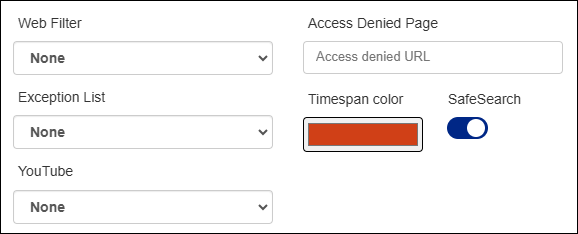
Select the appropriate filters to add to the selected policy from the drop-down lists. If you do not want to add a specific custom filter for a specific filter category, select None.
Type the URL in the Access Denied Page text box to direct students to a specific URL (e.g., your district’s web page) when access to a website is denied. If you activate Access Requests, then the default access denied page is used. If you do not have a specific URL redirect leave this text box empty and it will display the standard Blocksi Access Denied page when a blocked page is accessed.
Indicate the color for the time span on the chart.
Click the box corresponding to the appropriate hour of the desired day to define the time period. For example, to select school hours of Monday - Friday 8 AM - 4 PM, click and hold the Monday-8 tile and drag to the Friday-16 tile. Repeat steps 1-2 to create additional time periods.
Click Save Changes.
Create as many time periods in a policy as you wish. For example, let’s say you wanted to create time periods for in school, after school, and weekends. Open the policy and repeat the steps in Adding the Time Periods for each additional time period you want to add to the policy. The following example shows a time-based policy that contains the three time periods mentioned previously. Note that each time period uses a different color scheme to indicate the hours and days to which it applies. Choose any colors you want to represent the time periods you create.
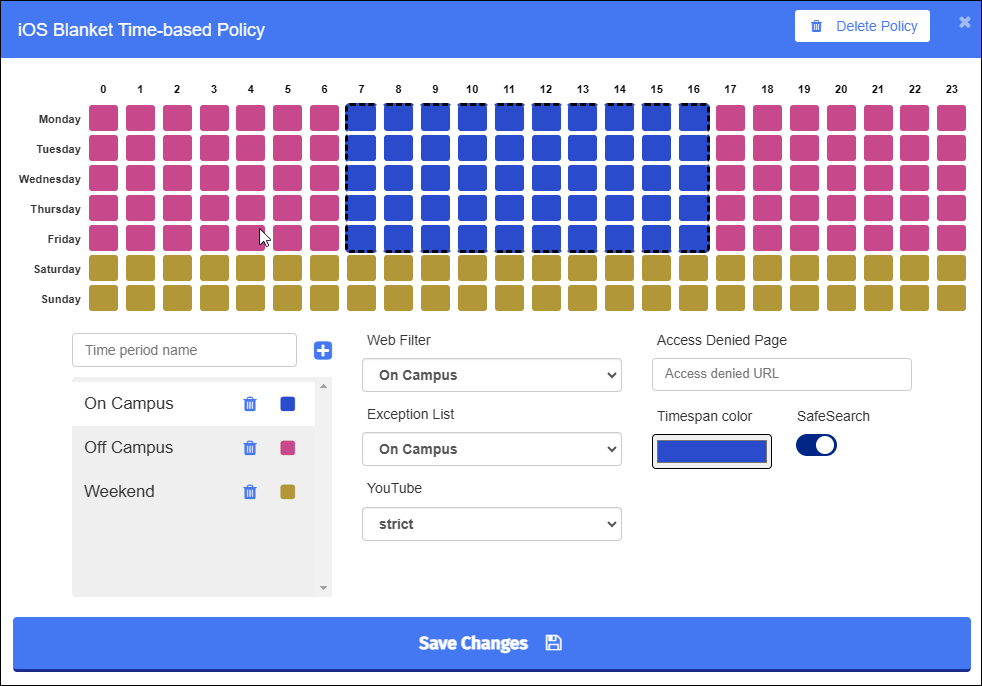
The DNS policy is time-based and allows school districts to filter content by DNS filtered IP addresses. A DNS policy is required to apply DNS-based filtering settings. See DNS Filtered IP Addresses for details on configuring DNS filtering settings.
Creating the Policy
Click Content Filtering from the Main Menu and then click Policies from its sub-menu. The Policies screen appears.

Type the name of the policy in the Enter policy name text field.
Select DNS from the Choose policy type drop-down list.
Click Create Policy +. The new policy appears in the Policy Table. and the following window opens. Note that time periods are in military time format.
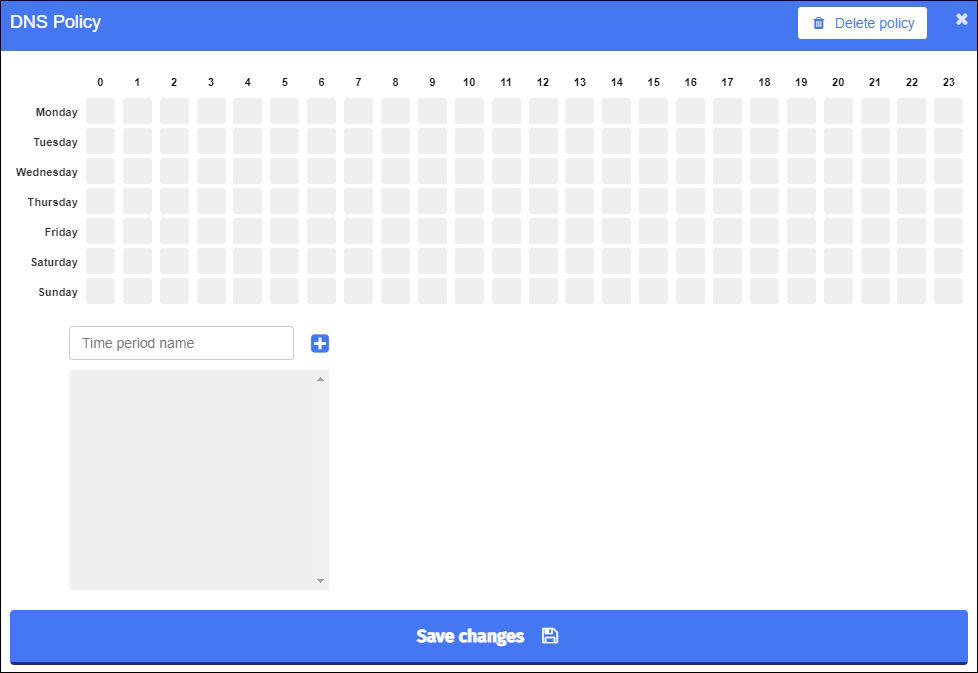
Adding the Time Periods
Type the name of the time period in the Time period name text box and click the blue plus sign. Time periods must have more than three characters. When you click the blue plus sign, the window expands to include the fields for the time-based policy, as shown below.
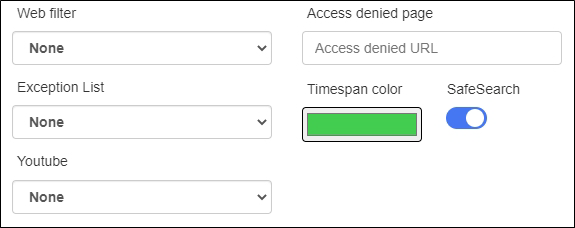
Select the appropriate filters to add to the selected policy from the drop-down lists. If you do not want to add a specific custom filter for a specific filter category, select None.
Type the URL in the Access Denied Page text box to direct students to a specific URL (e.g., your district’s web page) when access to a website is denied. If you activate Access Requests, then the default access denied page is used. If you do not have a specific URL redirect leave this text box empty and it will display the standard Blocksi Access Denied page when a blocked page is accessed.
Indicate the color for the time span on the chart.
Click the box corresponding to the appropriate hour of the desired day to define the time period. For example, to select school hours of Monday - Friday 8 AM - 4 PM, click and hold the Monday-8 tile and drag to the Friday-16 tile. Repeat steps 1-2 to create additional time periods.
Click Save Changes.
Create as many time periods in a policy as you wish. For example, let’s say you wanted to create time periods for in school, after school, and weekends. Open the policy and repeat the steps in Adding the Time Periods for each additional time period you want to add to the policy. The following example shows a time-based policy that contains the three time periods mentioned previously. Note that each time period uses a different color scheme to indicate the hours and days to which it applies. Choose any colors you want to represent the time periods you create.
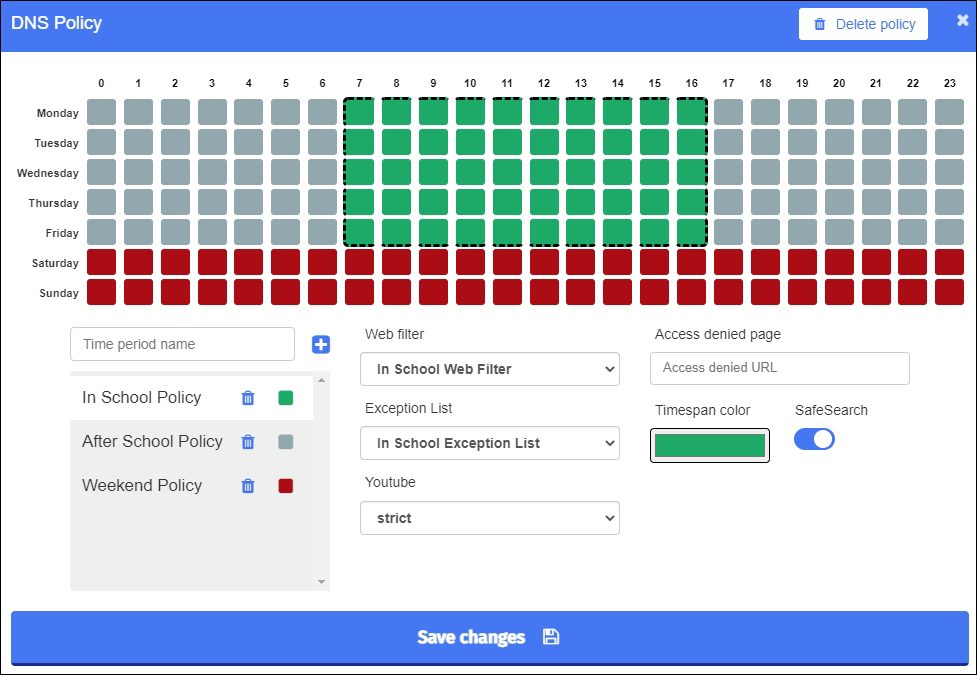
Note
Time periods apply only to Time-based, OSX Time-based, iOS Blanket Time-based, and DNS policies.
Delete time periods from policies when you no longer need them.
To delete a time period from a policy
Click Content Filtering from the Main Menu and then click Policies from its sub-menu. The Policies screen appears.

Click the name of the policy from which to delete the time period from the policy table. The policy window opens.
Click the
 icon to the right of the desired time period. A confirmation prompt appears.
icon to the right of the desired time period. A confirmation prompt appears.Click OK to delete the time period from the policy.
Click the white X in the top right corner of the window.
Set the threshold for the maximum number of times a student can view or attempt to view blocked pages. When the student exceeds this number, they are sent an email notifying them of their behavior.
To set the student threshold
Click Content Filtering from the Main Menu and then click Policies from its sub-menu. The Policies screen appears.

Click the Student Threshold button. The following window opens.
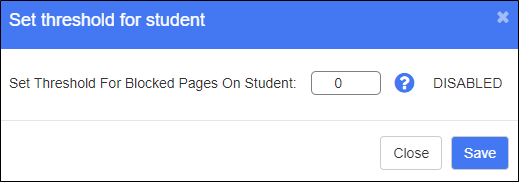
Set the threshold and click Save.
Modify policies whenever you need to make changes to them.
To modify a policy
Click Content Filtering from the Main Menu and then click Policies from its sub-menu. The Policies screen appears.

Click the name of the policy to modify from the policy table. The policy window opens.
Make the necessary changes, and click Save Changes.
Use an existing policy to create a new one.
To duplicate a policy
Click Content Filtering from the Main Menu and then click Policies from its sub-menu. The Policies screen appears.

Locate the policy to duplicate, and click the
 icon. The Duplicate Policy window opens.
icon. The Duplicate Policy window opens.
Type the name of the new policy in the text box.
Click OK. The duplicated policy appears at the bottom of the list. It contains the same filters and lists as the original policy.
Make any desired changes to the new policy and save it.
Export only regular policies to a PDF file to keep for your records.
To export a policy
Click Content Filtering from the Main Menu and then click Policies from its sub-menu. The Policies screen appears.

Click the name of the policy to export from the policy table. The policy window opens.
Click Export PDF in the lower right-hand corner of the window. The file appears in the lower left-hand corner of your screen in PDF format. Click it to open and save it.
When you make changes to filters, policies, DNS filtered IP addresses, and policy assignments, click Update Policies on All Clients to commit these changes. Note that Update Clients on All Policies flashes red to indicate that Blocksi has not yet committed outstanding changes.
To update policies on all clients
Click the Update Policies on All Clients button on the Action Bar.

A success prompt appears.
Click Close to remove the prompt.
Delete policies whenever when you no longer need them.
To delete a policy
Click Content Filtering from the Main Menu and then click Policies from its sub-menu. The Policies screen appears.

Click the name of the policy to delete from the policy table. The policy window opens.
Click the Delete Policy button at the top right of the policy window. A confirmation prompt appears.
Click OK to delete the policy from the policy table.